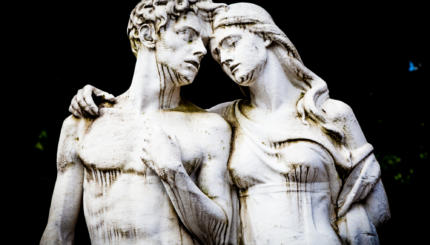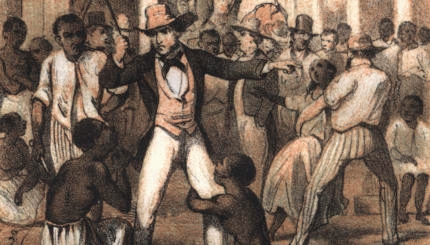On March 3, 1934, a group of young Jewish men helped change basketball history. On that night, fans in New York City watched with anticipation for the winner of a game between New York University (NYU) and City College of New York (CCNY).
The New York Times stated that the 20th annual meeting between the two schools had “never before … aroused such widespread interest,” as both teams entered the contest undefeated. The demand for tickets was such that promoters began a series of doubleheaders at Madison Square Garden the following season and turned New York City into the center of the basketball world.
The next year Newsweek ran a story on basketball’s rise to prominence and declared the sport was one “at which Jews excel.”
Both the NYU-CCNY game, in which nine of the 10 starters were Jewish, and the Newsweek article occurred during the peak of Jewish prominence in basketball. Yet, the story of Jewish basketball is more than either a single game or article. Centered in New York, Jews were crucial to the development of college and professional basketball during the first half of the 20th century.
A New Sport Gains Popularity
Invented by Dr. James Naismith at a Young Men’s Christian Association (YMCA) in 1891, basketball quickly became a popular sport that expanded into the broader society. As industrialization, immigration, and urbanization drastically transformed America at the turn of the 20th century, many Americans saw basketball as an ideal sport since it taught teamwork, cooperation, discipline, and obedience.

Help us keep Jewish knowledge accessible to millions of people around the world.
Your donation to My Jewish Learning fuels endless journeys of Jewish discovery. With your help, My Jewish Learning can continue to provide nonstop opportunities for learning, connection and growth.
During the Progressive era, the popularization of basketball among Jewish youth in urban areas primarily occurred both in settlement houses and at communal institutions. Jewish youth on New York’s Lower East Side played basketball on playgrounds and at schoolyards. The formation of the Public School Athletic League (PSAL) in the early 1900s allowed players to gain experience in organized, competitive settings.
By the middle of the decade, CCNY established a basketball team full of local Jewish men. Players such as Barney Sedran, Ira Streusand, and Harry Brill honed their skills at City College and upon graduating, began to play in the various professional leagues in eastern cities.
At the time, the definitions of “amateur” and “professional” constantly changed. Even college basketball, which had roughly 200 teams by 1910, remained relatively disorganized and was certainly not a national sport in the same sense as college football. These chaotic conditions allowed Jewish players to find a niche in the game, as neither college nor professional teams seemed interested in restricting Jews from participating.
Much of American society viewed professional basketball as a dirty and rough sport. Professionals played in cages made of rope or chicken wire in order to protect the players from unruly fans and to keep the ball in continuous play. There were no standards for the size of the court or the size of the ball, and contracts were nonexistent. Players jumped from team to team for better pay, sometimes even between games.
Jewish players led teams that won championships in numerous East Coast leagues. Yet the players themselves were relatively anonymous. But after World War I, basketball became more stable, starring a new generation of Jewish players.
Moving to the National Scene
In the early 1920s, Jewish basketball spread throughout the country. As neighborhoods stabilized due to immigration restriction, American-born children began to assimilate and embraced America’s sporting culture. Jewish players often played at YMHAs, synagogues, and community centers before and after their college or professional careers. But Jews were not always welcome in athletics outside of their own leagues.
The decade also saw anti-Jewish attacks intensify. When Harvard University ‘s president openly declared the need for quotas because Jewish students did not “fit in,” he was in part referring to the university’s athletic culture. In the midst of the controversy, as other schools such as Columbia, Yale, and Syracuse considered quotas, Yale University alumni demanded their coaches end discriminatory practices against Jewish basketball players in order to field a winning team. The American Hebrew newspaper wrote that Yale’s recognition of Jewish players proved that sports could help Jews receive acceptance on campus and facilitate integration.
Jewish prominence in basketball also helped the game itself spread. Nat Holman, who coached at CCNY, also played professionally for the Original Celtics, a former settlement house team that had Jewish, German, and Irish players. Holman and the Celtics have been credited for popularizing basketball throughout the country in the 1920s. During their long barnstorming trips to play teams in the South and the Midwest, the Celtics wowed local audiences with their strategies, skills, and showmanship. They played more than 100 games per year and often lost fewer than ten.
The popularity of the Celtics convinced promoters of basketball’s commercial appeal and led to the development of a national league called the American Basketball League (ABL) in 1925. Holman and other Jews played in the league until it folded due to financial problems caused by the Depression.
In the 1930s, Jewish entrepreneurs established independent teams such as the New York Hakoahs (From the Hebrew word for strength) and the Philadelphia Sphas (an acronym for the South Philadelphia Hebrew Association). Jewish players were prominent in a new ABL that formed in the early 1930s, but the professional game remained limited as a semi-professional and regional sport. Teams played in urban neighborhoods in the Northeast and players often both lived and worked close to their fans.
The Rise and Fall of Jewish Basketball
While professional basketball remained a marginal sport during the Depression, college basketball became one of the most popular sports in the country. At Madison Square Garden, Jewish players filled the rosters of New York schools such as NYU, CCNY, Long Island University, and St. John’s University that hosted teams from around the country.
The mainstream press began to focus on a specific playing style of New York schools based on constant motion, quick passing, and deliberate cuts to the basket. Both Jewish and non-Jewish commentators connected this style to the mental acuity and lack of size of Jews. This style challenged Western teams who played with the more open, fast-breaking style. The doubleheaders became testing grounds for regional supremacy.
From the late 1930s to the early 1950s, the Garden also hosted the National Invitational Tournament (NIT) and the NCAA Tournament. Teams with prominent Jewish players won five of the first seven NITs. In 1950, Holman’s CCNY team, with primarily Jewish players, won both tournaments. Called the “Grand Slam,” the accomplishment was never repeated.
Along with schools such as Kentucky and NYU, however, the CCNY team was embroiled in a point shaving scandal in the early 1950s. Players accepted money from gamblers to either lose games on purpose or win by less than the point spread. The scandal almost destroyed college basketball and led to the demise of New York college basketball, which diminished a centralized Jewish playing presence in the sport.
The scandal was not the only reason for Jewish basketball’s downfall. A formal league called the Basketball Association of America (BAA) had been established in 1946, and was renamed the National Basketball Association (NBA) in 1950. Jewish players at the time typically had other jobs during the season and were accustomed to playing semi-professionally. Few remained in the league, as basketball could not support their families.
Socio-economic success also contributed to the decline of Jews in basketball. Moving to the suburbs created more opportunities to succeed in mainstream society. Sports became less important and though Jews continued to play basketball, they did so in a different environment than the urban street culture of the heyday of Jewish basketball.
There were still a few Jewish players who made it to the top of the game such as Lennie Rosenbluth and Art Heyman in the 1950s and 1960s. But since the early 1970s, Jews have been primarily coaches, general managers, and owners in college and professional basketball. Among the most prominent are Hall of Fame coach Larry Brown, NBA commissioner David Stern, Dallas Mavericks owners Mark Cuban, and Washington Wizards general manager and former player Ernie Grunfeld.
The rise of Jewish basketball reflected American Jews’ larger story during the first half of the 20th century. From immigrant neighborhoods, Jews sought out opportunities to join the mainstream. Success in basketball is just one story of achievement during a time of adjustment, stress, and occasional anti-Semitism. At the same time, Jews made a lasting contribution to the game. While few Jews played at the highest levels, the sport owes its development to its roots with the Jewish neighborhoods teams.




